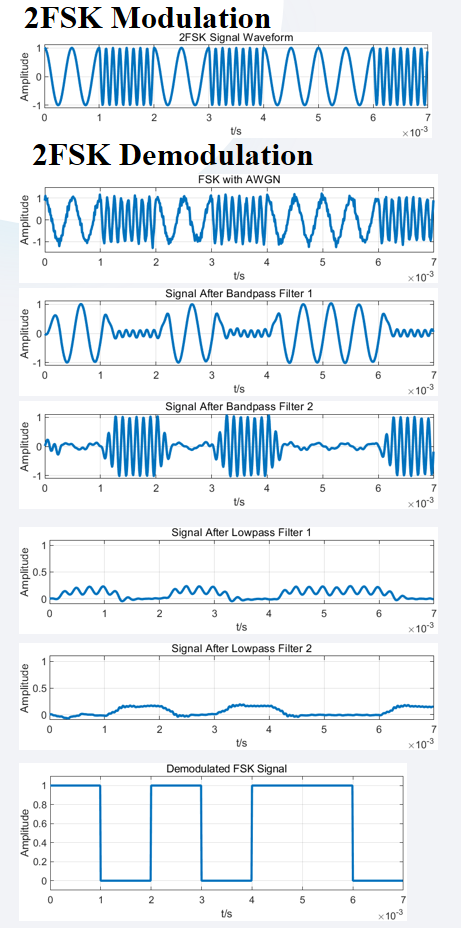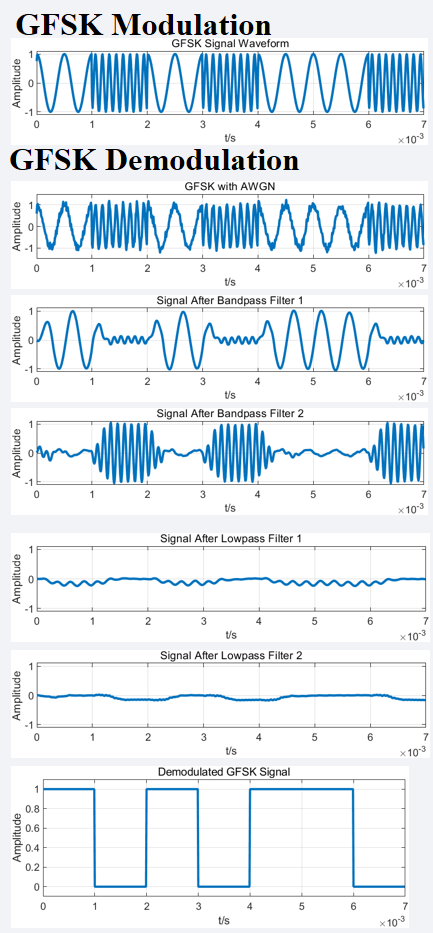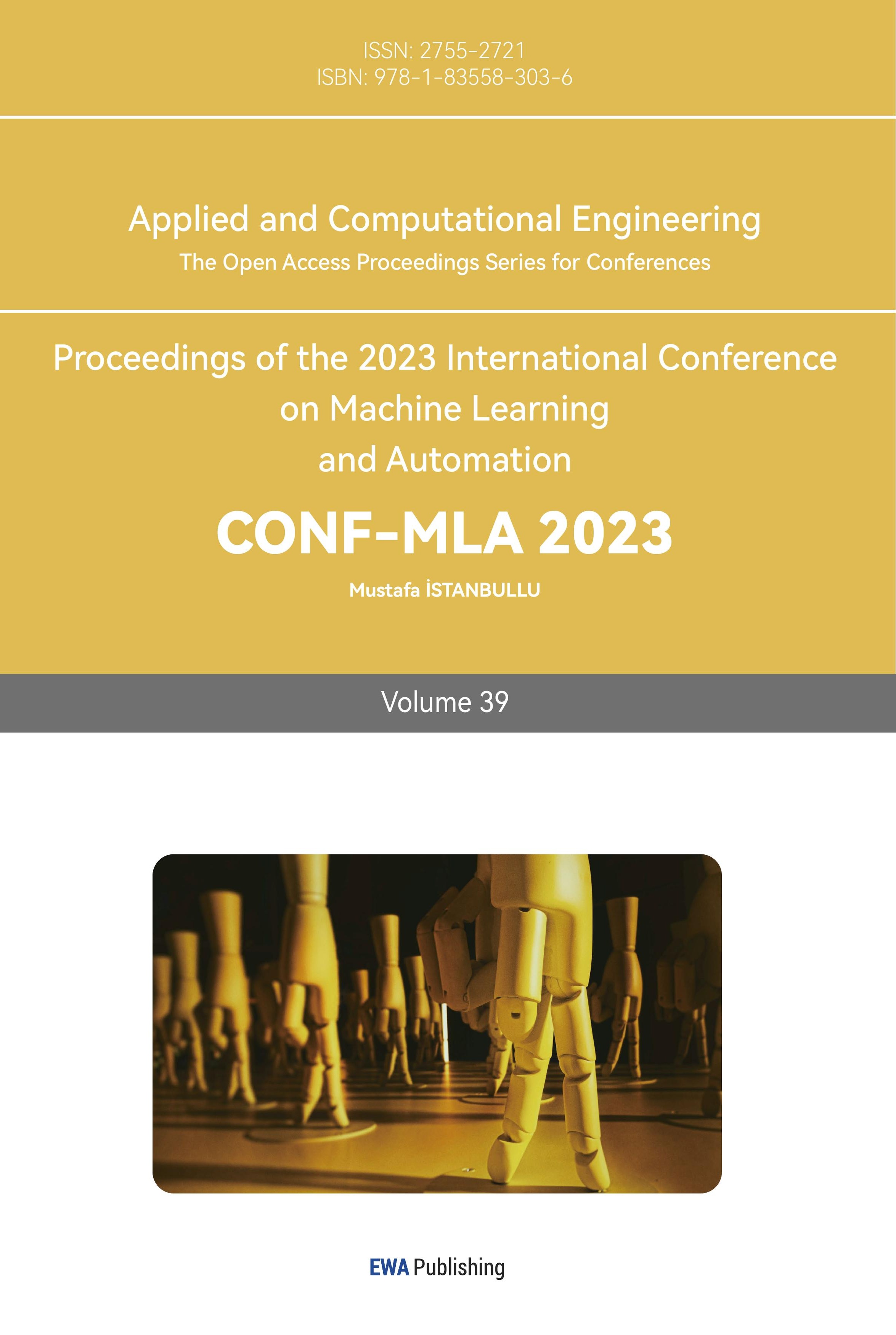1. Introduction
In the era of digital communication, the transmission and reception of data are integral to various applications [1], ranging from mobile communication to satellite systems [2]. Digital modulation, the process of converting digital bits into a suitable format for transmission over a medium, plays a crucial role in making these systems both efficient and reliable [3].
The use of digital modulation has become increasingly vital in the modern age, owing to its ability to transmit information over long distances with minimal loss of integrity. Furthermore, it allows for the utilization of complex algorithms that enhance data integrity and enable secure communication. As the demand for higher data rates and more robust connections continues to grow, the role of digital modulation techniques becomes even more significant.
Frequency Shift Keying (FSK) is one of the widely used digital modulation techniques that encode digital information in the frequency domain. It involves the use of different carrier frequencies to represent different digital states. The simplest form is binary FSK, where two frequencies are used to denote the two binary states, 0 and 1.
FSK is favoured for its simplicity and ability to operate over noisy channels. It is used in various applications such as fax machines, wireless LANs, and radio broadcasting, reflecting its adaptability and effectiveness [4]. Further variations of FSK, such as 2-level Frequency Shift Keying (2FSK) and Gaussian Frequency Shift Keying (GFSK), offer different advantages and are suited for specific applications, providing a broader spectrum of possibilities in the realm of digital communications [5].
2. 2FSK Modulation
2.1. Definition and Principles
2FSK, or 2-level Frequency Shift Keying, is a type of digital modulation where the frequency of a carrier signal is shifted between two discrete values, representing binary values 0 and 1. In the context of digital communication, 2FSK is particularly useful due to its simplicity and efficiency in transmitting binary data over a noisy channel.
2.2. Mathematical Representation
The mathematical expression for 2FSK can be given as:
\( s(t)=cos(2πfit+ϕ) \) (1)
where \( f \) represents the frequency of the carrier signal, selected based on the input binary data, and \( ϕ \) is the phase. The two frequency values, 0f0 and 1f1, correspond to the binary values 0 and 1, respectively.
2.3. Modulation Process
In 2FSK, binary data is the input to the modulation process. A ‘0’ is represented by one frequency, say 0f0, and a ‘1’ is represented by another frequency, say 1f1.
2.4. Frequency Selection
The frequency selection in 2FSK is done based on the binary data being transmitted. If the binary bit is 0, the frequency 0f0 is selected; if the binary bit is 1, the frequency 1f1 is selected. This frequency shift encodes the information in the carrier signal.
2.5. Applications of 2FSK
2FSK modulation is widely used in various applications, including low-data-rate wireless communication, telemetry, and remote-control systems. Its simplicity makes it a preferred choice for systems where power efficiency and reliability are crucial.
3. Advantages and Disadvantages of 2FSK
3.1. Advantages of 2FSK
The 2FSK has the following advantages:
Simplicity: 2FSK is relatively simple to implement and understand.
Robustness: It is less susceptible to noise compared to other modulation schemes, providing a more robust communication link.
3.2. Disadvantages of 2FSK
The 2FSK has the following disadvantages:
Bandwidth Efficiency: 2FSK can be less bandwidth-efficient compared to more complex modulation schemes like QAM or QPSK.
Limited Data Rate: The data rate for 2FSK is typically lower, making it less suitable for high-data-rate applications.
2FSK Modulation provides an essential and practical method for binary data transmission, especially in scenarios where simplicity and robustness are prioritized. While it may lack the high-data-rate capabilities of more complex modulation methods, its ease of implementation and resilience to noise continue to make it a valuable tool in various fields of communication.
4. GFSK Modulation
4.1. Definition and Introduction to Gaussian Filtering
GFSK, or Gaussian Frequency Shift Keying, is a modulation scheme where the frequency modulation is shaped by a Gaussian filter to reduce spectral width [6]. Unlike traditional FSK, where the frequency is shifted abruptly, GFSK employs Gaussian filtering to provide a smoother transition between the frequency shifts [7]. This leads to improved bandwidth efficiency and reduced inter-symbol interference [8].
4.2. Mathematical Representation
The Gaussian filter is characterized by its 3-dB bandwidth and the modulation index. The mathematical expression of the Gaussian function is given by:
\( g(t)=exp(-2σ2t2) \) (2)
where \( σ \) determines the width of the Gaussian filter. The GFSK signal can be represented as a continuous-time expression based on this Gaussian function.
4.3. Modulation Process
Use of Gaussian Filter. In GFSK modulation, the Gaussian filter shapes the modulating signal before applying frequency modulation. The smooth transitions between symbols minimize spectral spread, allowing for better spectral efficiency.
4.4. Bandwidth Efficiency
GFSK modulation provides better bandwidth efficiency by reducing the spectral occupancy of the signal. This allows for closer channel spacing without significant inter-channel interference, enabling more efficient use of the available frequency spectrum.
4.5. Applications of GFSK
GFSK is widely used in various wireless communication systems, such as Bluetooth, where bandwidth efficiency is paramount. It’s particularly suitable for low-power, short-range applications where spectral efficiency and robustness against interference are critical.
5. Advantages and Disadvantages of GFSK
5.1. Advantages of GFSK
The GFSK has the following disadvantages:
Bandwidth Efficiency: GFSK’s use of Gaussian filtering allows for more efficient use of available bandwidth.
Reduced Inter-Symbol Interference: The smooth frequency transitions minimize interference between consecutive symbols.
Robustness: GFSK tends to be more robust against noise and other distortions compared to some other modulation schemes.
5.2. Disadvantages of GFSK
The GFSK has the following disadvantages:
Complexity: The use of Gaussian filtering adds complexity to the modulation process, which may lead to increased implementation cost.
Potential Performance Trade-offs: Depending on filter design and system requirements, GFSK may present trade-offs between bandwidth efficiency and bit error rate performance.
GFSK Modulation represents an advancement over traditional FSK by employing Gaussian filtering to shape the modulating signal. Its advantages in bandwidth efficiency and reduced inter-symbol interference make it a popular choice in modern wireless communication systems. However, careful consideration must be given to its implementation to balance complexity and performance.
6. 2FSK and GFSK Demodulation
6.1. Definition of Demodulation
Demodulation is the process of extracting the original information-bearing signal from a modulated carrier wave [9]. In digital communication systems, demodulation is employed to recover the digital data that has been modulated onto a carrier frequency [10].
6.2. 2FSK Demodulation
2FSK (2-level Frequency Shift Keying) demodulation is achieved by detecting the frequency changes corresponding to the digital information in the received signal. Various techniques can be employed for this purpose, including Zero-Crossing Detectors, Phase-Locked Loops (PLLs), and Matched Filters. These methods rely on measuring the frequency of the received signal and mapping it to the corresponding binary data.
The implementation of 2FSK demodulation typically involves signal conditioning, frequency detection, and decision-making stages. Signal conditioning may include filtering to remove noise. Frequency detection can be accomplished using one of the aforementioned techniques, followed by a decision-making process to interpret the detected frequencies as binary data. Proper synchronization and thresholding play crucial roles in achieving accurate demodulation.
6.3. GFSK Demodulation
GFSK demodulation is more complex due to the Gaussian filtering applied during modulation. Techniques like the Viterbi Algorithm, Matched Filters, or Quadrature Demodulation can be employed. These methods must be capable of handling the gradual transitions between symbols, characteristic of GFSK, to accurately recover the original data.
GFSK demodulation implementation typically involves pre-processing, frequency detection, and decision-making stages. Pre-processing may include Gaussian filtering to match the modulation process. Frequency detection is achieved through one of the specialized techniques mentioned earlier, followed by decision logic to interpret the detected frequencies. Tuning the parameters to match the Gaussian filter used in modulation is vital for optimal performance.
6.4. Comparison between 2FSK and GFSK Demodulation
While both 2FSK and GFSK are frequency modulation schemes, GFSK incorporates a Gaussian filter, leading to differences in demodulation. GFSK tends to be more bandwidth-efficient but requires more complex demodulation techniques. 2FSK, on the other hand, offers simpler demodulation methods but may suffer from higher bandwidth usage. The choice between the two depends on the specific requirements of the application, such as speed, bandwidth efficiency, and system complexity.
In conclusion, 2FSK and GFSK demodulation both serve to recover digital data from modulated signals but differ in techniques and implementation. Understanding the underlying principles and characteristics of each enables informed decisions in communication system design.
6.5. Test:2FSK and 2GFSK Modulation and Demodulation
The simulation test was carried out with the following parameters:
Number of symbols: M = 7
Number of samples per symbol: nsample = 100
Symbol duration: Ts = 0.001
Symbol rate Z: Rb = 1/Ts
Sampling interval: dt = Ts/nsample
Total time: tt = M*Ts
Time: t = 0:dt:tt-dt
Sampling frequency: fs = 1/dt
A case of random binary sequence is shown in Figure 1.

Figure 1. A case of random binary sequence.
Applying the 2FSK and GFSK techniques, the modulation and demodulation results of 2FSK and GFSK are shown in Figure 2 and Figure 3 respectively. Figure 4 shows the comparison of frequency spectrums.
The random binary sequence (shown in Figure 1) serves as the foundational input for the simulation. In digital communications, information is often represented in the form of binary sequences. The characteristics of this sequence, such as bit rate and length, might influence the subsequent modulation results.
It can be seen from Figure 2 that 2FSK is a frequency-based modulation technique where two distinct frequencies represent the binary states of 0 and 1. Being frequency-based, one might expect to see two prominent peaks in the spectrum. The spacing and amplitude of these peaks could be influenced by the input binary sequence.
It can be seen from Figure 3 that GFSK is a variant of FSK that employs a Gaussian filter to smooth out the transitions of the signal. This implies that in the spectrum, GFSK might exhibit a broader main lobe and reduced side lobes compared to 2FSK. This is attributed to the Gaussian filter’s ability to mitigate abrupt frequency changes, thereby narrowing the spectrum’s width.
Figure 4 presents a direct comparison of the spectrums of 2FSK and GFSK. From this comparison, one can infer that the spectral efficiency of GFSK might be superior, as its main lobe could be narrower and side lobes diminished. This is due to GFSK’s incorporation of the Gaussian filter to smooth signal transitions.

Figure 2. Modulation and demodulation results of 2FSK.

Figure 3. Modulation and demodulation results of GFSK.

Figure 4. Comparison of frequency spectrums.
7. Future Trends and Developments
The landscape of digital modulation, particularly in the realms of 2FSK and GFSK, is ever-evolving [11].
7.1. Emerging Technologies
In the rapidly advancing world of communication technology, new innovations are continually being developed. These emerging technologies may include advancements in signal processing, machine learning applications in modulation, and novel hardware designs. The integration of these technologies could redefine the efficiency and capabilities of digital modulation techniques.
7.2. Research Directions
The research in digital modulation is multifaceted and continues to expand into new horizons. Current research directions may involve the exploration of more energy-efficient modulation methods, the development of robust algorithms for noisy environments, and the investigation of cross-disciplinary applications such as in healthcare or automotive industries. Understanding these research avenues is vital for both academia and industry to align their efforts in pushing the boundaries of what is possible.
7.3. Potential Impact on Industry and Technology
The innovations and research in 2FSK and GFSK modulation are not confined to theoretical explorations; they have tangible impacts on various industries and technologies. The potential impact includes enhancing the speed and reliability of wireless communication, enabling more secure data transmission, and fostering the growth of Internet of Things (IoT) applications. These advancements could lead to transformative changes in sectors such as telecommunications, manufacturing, and transportation, thereby shaping the future technological landscape.
In summary, the future trends and developments in digital modulation are poised to bring significant changes and opportunities. By examining emerging technologies, understanding current research directions, and assessing the potential impact on industry and technology, this section provides a comprehensive view of the exciting prospects that lie ahead in the field of digital modulation.
8. Conclusions
In this paper, we have explored the principles and applications of both 2FSK and GFSK modulation and demodulation techniques. The mathematical representations were discussed, and the modulation processes were detailed, including the use of Gaussian filtering in GFSK. A comparative analysis between 2FSK and GFSK was conducted, focusing on aspects such as SNR and BER. Real-world implementations and challenges were also examined.
The findings of this study have significant implications for the field of digital communication. The insights into the advantages and disadvantages of both 2FSK and GFSK provide valuable information for engineers and researchers working on communication systems. The comparison between these two techniques sheds light on their suitability for various applications, potentially guiding future technological choices.
Based on the analysis and insights gained, we recommend further research into the optimization of GFSK modulation for bandwidth efficiency. Additionally, the development of robust demodulation techniques for both 2FSK and GFSK should be a priority. Collaboration between academia and industry could foster innovation and lead to the creation of more efficient and reliable communication systems. The exploration of emerging technologies in the context of 2FSK and GFSK may also pave the way for groundbreaking advancements in the field.
References
[1]. Chitode J S 2009 Digital Communication (Pune: Technical Publications)
[2]. Gibson J D 2010 The Communications Handbook (Florida: CRC Press)
[3]. Lee W C Y 2006 Mobile Cellular Telecommunications (New York: McGraw-Hill)
[4]. Wozencraft J M, Jacobs I M 1965 Principles of Communication Engineering (New York: Wiley)
[5]. Viterbi A J 1995 CDMA: Principles of Spread Spectrum Communication (California: Addison-Wesley)
[6]. Zhang, L., & Wang, Z. (2019). Research on GFSK modulation and demodulation technology. Journal of Physics: Conference Series, 1304(1), 012091. IOP Publishing.
[7]. Kumar, P., & Sharma, S. K. (2017). Performance analysis of M-ary FSK in the presence of co-channel interference and noise in wireless communication. Materials Today: Proceedings, 4(2), 2300-2306. Elsevier Ltd.
[8]. Wang, Z., & Zhang, L. (2019). A novel GFSK modulation and demodulation technology. Journal of Physics: Conference Series, 1304(1), 012092. IOP Publishing.
[9]. Li, J., & Zhang, Y. (2018). Research on modulation and demodulation technology of 2FSK signal. Journal of Physics: Conference Series, 1064(1), 012043. IOP Publishing.
[10]. Kumar, P., & Sharma, S. K. (2017). Performance analysis of M-ary FSK in the presence of co-channel interference and noise in wireless communication. Materials Today: Proceedings, 4(2), 2300-2306. Elsevier Ltd.
[11]. Zhang, L., & Wang, Z. (2019). Research on GFSK modulation and demodulation technology. Journal of Physics: Conference Series, 1304(1), 012091. IOP Publishing.
Cite this article
Xing,S. (2024). Comparative study of 2FSK and GFSK modulation and demodulation techniques. Applied and Computational Engineering,39,251-259.
Data availability
The datasets used and/or analyzed during the current study will be available from the authors upon reasonable request.
Disclaimer/Publisher's Note
The statements, opinions and data contained in all publications are solely those of the individual author(s) and contributor(s) and not of EWA Publishing and/or the editor(s). EWA Publishing and/or the editor(s) disclaim responsibility for any injury to people or property resulting from any ideas, methods, instructions or products referred to in the content.
About volume
Volume title: Proceedings of the 2023 International Conference on Machine Learning and Automation
© 2024 by the author(s). Licensee EWA Publishing, Oxford, UK. This article is an open access article distributed under the terms and
conditions of the Creative Commons Attribution (CC BY) license. Authors who
publish this series agree to the following terms:
1. Authors retain copyright and grant the series right of first publication with the work simultaneously licensed under a Creative Commons
Attribution License that allows others to share the work with an acknowledgment of the work's authorship and initial publication in this
series.
2. Authors are able to enter into separate, additional contractual arrangements for the non-exclusive distribution of the series's published
version of the work (e.g., post it to an institutional repository or publish it in a book), with an acknowledgment of its initial
publication in this series.
3. Authors are permitted and encouraged to post their work online (e.g., in institutional repositories or on their website) prior to and
during the submission process, as it can lead to productive exchanges, as well as earlier and greater citation of published work (See
Open access policy for details).
References
[1]. Chitode J S 2009 Digital Communication (Pune: Technical Publications)
[2]. Gibson J D 2010 The Communications Handbook (Florida: CRC Press)
[3]. Lee W C Y 2006 Mobile Cellular Telecommunications (New York: McGraw-Hill)
[4]. Wozencraft J M, Jacobs I M 1965 Principles of Communication Engineering (New York: Wiley)
[5]. Viterbi A J 1995 CDMA: Principles of Spread Spectrum Communication (California: Addison-Wesley)
[6]. Zhang, L., & Wang, Z. (2019). Research on GFSK modulation and demodulation technology. Journal of Physics: Conference Series, 1304(1), 012091. IOP Publishing.
[7]. Kumar, P., & Sharma, S. K. (2017). Performance analysis of M-ary FSK in the presence of co-channel interference and noise in wireless communication. Materials Today: Proceedings, 4(2), 2300-2306. Elsevier Ltd.
[8]. Wang, Z., & Zhang, L. (2019). A novel GFSK modulation and demodulation technology. Journal of Physics: Conference Series, 1304(1), 012092. IOP Publishing.
[9]. Li, J., & Zhang, Y. (2018). Research on modulation and demodulation technology of 2FSK signal. Journal of Physics: Conference Series, 1064(1), 012043. IOP Publishing.
[10]. Kumar, P., & Sharma, S. K. (2017). Performance analysis of M-ary FSK in the presence of co-channel interference and noise in wireless communication. Materials Today: Proceedings, 4(2), 2300-2306. Elsevier Ltd.
[11]. Zhang, L., & Wang, Z. (2019). Research on GFSK modulation and demodulation technology. Journal of Physics: Conference Series, 1304(1), 012091. IOP Publishing.









